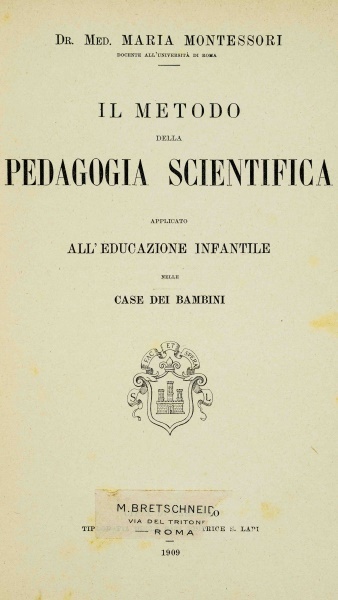Montessori: ‘The Montessori Method’
Maria Montessori was born into a well-off Italian family at a time career paths for women were determined by tradition rather than personal choice. In spite of this, in 1896 she became the first woman in Italy to earn her medical degree (Gutek 5). Along with having a career in medicine, Montessori was an advocate for what she called the “new woman,” asserting that all women, regardless of social class, were just as qualified for opportunity as men (5).
Montessori is best known for her influential teaching philosophy described in The Montessori Method. The book sold quickly through six editions, and her pedagogical approach was popularized alongside the progressive education movement. In fact, in the four years after the publication of Montessori’s Method, more than 100 Montessori schools opened in the United States.
Although scientific-based instruction is now pervasive in teacher education, Montessori’s method was among the first to be marketed as empirically grounded. Her anthropological observation of how children learn and develop in natural settings formed the basis of the pedagogy and linked back to two overarching principles drawn from her research:
- Children’s psychological development occurs through interactions within their environment.
- Each stage of psychological development is hastened and optimized through interactions within the environment that encourage growth of innate tendencies.
Based on her observations, Montessori believed that the role of the teacher was to observe and direct children’s psychological, physical, and social development with the overall aim of cultivating children’s independence.
Outlined in detail in The Montessori Method, this philosophy gives children freedom to use provided educational materials without strict instruction or force (Foschi 239). Her teaching methods tempered the acquisition of subject knowledge with choice, autonomy, interest, and routine. Instead of receiving direct instruction, students select from a choice of activities through which they gradually discover and apply underlying concepts. She established mixed-age classrooms that allowed for large blocks of uninterrupted work time. Self-discipline emerged from deep interest and involvement in activities and learning materials made available in the learning environment.
While it focused on reading, writing, and arithmetic, Montessori’s pedagogy was innovative for integrating these skills within practical activities that focused on formation of the whole child. These areas included diet, fitness (muscular education through gymnastics), the natural world (working directly with plants and animals), manual labor (art and building), and the education of the senses. Choice of practical activities guided by trained educators compelled students to learn and apply “the three R’s” in an experiential manner until gradually coming into convention.
Finally, the Montessori Method was innovative for recognizing the relationship between the social environment and independence in learning. Environments allowed freedom of movement; classroom furnishings and activities were scaled to the students’ size and abilities. Child-sized materials were placed on low, accessible shelves. Child-sized tables and chairs were light enough for the children to move.
Each of these innovations stemmed from Montessori’s commitment to cultivating the agency and independence of children and her fervent belief that an education should help one to accommodate inner drives and tendencies in spite of society’s imperialist demands (Duckworth 42). In the first chapter of The Montessori Method, Montessori writes, “The real punishment of normal man is the loss of consciousness of that individual power and greatness which are the sources of his inner life. Such a punishment often falls upon men in the fullness of success” (26). Her philosophy aimed to re-instill an awareness of this power in children; for some, it seems, this worked.
The Wall Street Journal lists Larry Page and Sergei Brin (the founders of Google), Jeff Bezos (founder of Amazon), Jimmy Wales (founder of Wikipedia), Julia Child, and Sean “P. Diddy” Combs all as Montessori alumni (Sims).
—Treavor Bogard, PhD, Assistant Professor, Teacher Education
Treavor Bogard, assistant professor of teacher education, explains the anthropological roots of Maria Montessori’s pedagogical methods and their impact on contemporary theories of learning. Interview is an online supplement to the University of Dayton exhibit Imprints and Impressions: Milestones in Human Progress—Highlights from the Rose Rare Book Collection, held Sept. 29 through Nov. 9, 2014.
Works Cited
Duckworth, Cheryl. “Teaching Peace: A Dialogue On The Montessori Method.” Journal of Peace Education 3.1 (2006): 39-53. Academic Search Complete. Web. 19 Apr. 2014.
Foschi, Renato. “Science And Culture Around The Montessori’s First ‘Children’s Houses’ In Rome (1907–1915).” Journal of The History Of The Behavioral Sciences 44.3 (2008): 238- 257. Academic Search Complete. Web. 19 Apr. 2014.
Gutek, Gerald Lee. Introduction. The Montessori Method: The Origins of an Educational Innovation: Including an Abridged and Annotated Edition of Maria Montessori’s The Montessori Method. Lanham, MD: Rowman & Littlefield, 2004. Print.
Montessori, Maria. The Montessori Method. Trans. Anne E. George. Cambridge: Robert Bentley, 1964. Print.
Sims, Peter. “The Montessori Mafia.” The Wall Street Journal. 5 April 2011. Web. 19 April 2014.

